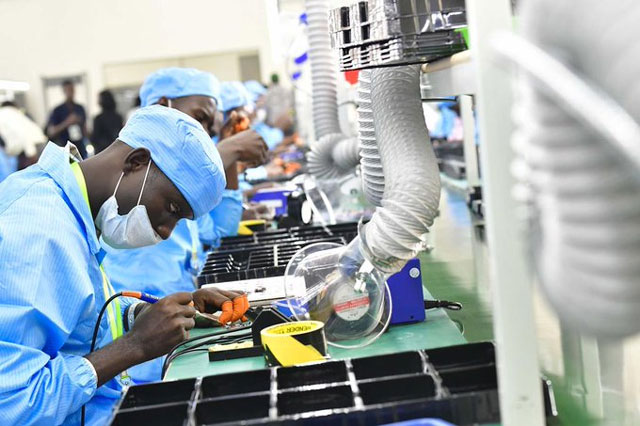
Kampala, Uganda | THE INDEPENDENT | To get just one working mobile phone device fitted together from series of metallic and plastic components screwed takes many hands and heads working together for several hours if not minutes.
At every stage of assembly, all Mobile phone components must be carefully tested to ensure they are in good and normal working mode because an error in one will compromise the functionality of the entire gadget.
That is what tech engineers don’t want to hear to guarantee the reputation of the company and keep the money tap flowing through the years.
So, how do they prevent that from happening?
*****
Come with me inside a guided tour of SIMI Mobile (S300) Assembly Plant, Uganda’s first Mobile Phone Assembly Plant in Namanve Industrial Park in Mukono district.
Taking me around is Samuel Wamala, an Assembly Line Leader at SIMI Mobile Phone Assembly plant. The plant is built by a Chinese Firm ENGO Holdings Limited to assemble Analog, Smart Phones and Laptops. It is already producing the analog type as it prepares for the Smart phones and the Laptops.
******
Wamala says the plant relies on motherboards or electrical circuit boards designed from China.
Compared to humans, the motherboards perform the critical function of the Human Heart – pumping life around the body.
In the case of a mobile phone, it must pump electrical signals from one keypad to another in a coordinated manner for the brain or the memory to click into action.
Today, I commissioned Uganda’s first mobile phone and computer manufucting and assembling factory in Namanve Industrial Park, Wakiso District. @FrankTumwebazek @NITAUganda1 @HonAniteEvelyn pic.twitter.com/RH0m3k07GA
— Yoweri K Museveni (@KagutaMuseveni) November 22, 2019
Wamala says when consignments of various component arrive from China where they are designed and programmed, their first job is to subject them to electrical functionality tests.
On top of this test is the motherboard itself, examined using a customized motherboard testing machine otherwise manually using a small drop of water. In contact with water, Wamala says the motherboard’s waterproof seal changes colour to signal fault.
When the programmed motherboard testing machine approves the functionality of the circuit board, it is passed to a waiting technician competent in fitting the first vital sets of components such as the keypads, blue tooth, mouth piece, its vibrator and speaker one after another as Wamala explains.
To ensure that the phone parts are not damaged during shipping, they are given seals from China which must be carefully taken off during assembly for these various parts to be electrically welded onto the motherboard. Wamala says the seals are removed from all the components of the phone.
The mobile phone is a mini Computer. In an assembly like this, this piece of technology must be given a lovely screen for it to appeal to the human eyes. Wamala says the process of fitting this interface is delicate because dust is alien to its operation.
When the screen or user interface which enables the electronic gadget to decade the human message has been firmly fitted into place, the hardware is screwed tightly into place. At this stage, the phone gets its front and back ends in place.
Sights at Namanve as we await H.E @KagutaMuseveni to officially open Uganda’s first ICT Manufacturing and Assembling Factory.#DigitizeUg pic.twitter.com/JexeiEaMDJ
— NITA-Uganda (@NITAUganda1) November 22, 2019
Wamala says they then use an electronic screw driver to fit the two ends together. He says onwards, the phone moves to another stage of production – quality checks.
At this stage, the phone is again subjected to another electronic test to determine its signal reception and readiness to call the international emergency number 112. And this is the job of Christine Kawunde, a Quality Assurance Manager.
When the signal is working fine, the phone enters an enclosed room where it is dusted using pressurized cylinder to ensure that no dust is trapped inside especially onto the screen. It is then electronically given a unique 15-digits International Mobile Equipment Identity (IMEI) number.
Wamala says this stage is critical to ensure that the phone looks new and appealing to customers.
When everything is working fine, the phones is cleaned and verified against the ISO 9001 quality requirements. They are then packed with their chargers and batteries separately and sealed in their boxes for the markets.
President Yoweri Museveni commissioned the plant on Friday.
******
URN
 The Independent Uganda: You get the Truth we Pay the Price
The Independent Uganda: You get the Truth we Pay the Price




Hi friends, its wonderful post about cultureand fully explained,
keep it up all the time.
This is so amazing and i would like to take part or get a vacancy to the phone and laptop assembling am a self employee at my workshop repairing phones, laptops and tvs but I would like to join the factory